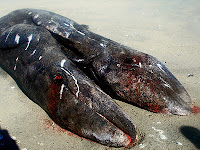The oceans are vast and mysterious places. In some ways, we
know more about outer space than we do the ocean depths.
Sailors have been spinning tales of amazing and terrifying sea monsters since ancient times. As outlandish as these stories are, the idea behind them, the events that spawned them, were likely inspired by real creatures.
TWO-HEADED CREATURE
In December, 2016, scientists discovered the strangest
creature washed ashore on Mexico's Laguna Ojo de Liebre that they had ever
seen. The creature was approximately seven feet long, dark gray in color, had
fins on each side, and had two tails. It also appeared to have four eyes.
Definitely a sea monster of some type? In reality, it turned out to be a pair
of extremely rare newborn conjoined gray whale twins. Since newborn gray whales
are about twelve feet long, scientists speculated that the pair was likely the
result of a miscarriage.
MONTAUK MONSTER
In the summer of 2008, an unidentified dead animal washed up
on the shore at Montauk, New York. Although several people reported seeing it
and photographs surfaced, the carcass disappeared before police were able to
recover the remains. Newspapers ran the story along with a grotesque image.
Locals speculated that it could be a mutant resulting from experiments at
nearby Plum Island Animal Disease Center. Others suggested that it was nothing
more than a hoax. Many scientists who studied the photographs think it was a
known species heavily damaged and decomposed as a result of time spent in the
water. Several people claimed it was some type of sea turtle without its shell.
The raccoon claim seems to be the closest, but the Montauk Monster's legs are
longer than a normal raccoon leaving us without a definitive conclusion.
OARFISH
Oarfish are
large, greatly elongated fish that are found in all temperate to tropical
oceans yet rarely seen. The giant oarfish is the longest bony fish alive (not
longest fish, cartilage fish such as the whale shark are longer), growing up to
36 ft. in length.
The common name oarfish is thought to be in reference either to their highly compressed and elongated bodies or to the now discredited belief that the fish row themselves through the water with their pelvic fins. The occasional beachings of oarfish after storms and their habit of lingering at the surface when sick or dying make oarfish a probable source of many sea serpent tales.
GIANT SQUID
The giant squid remains largely a mystery to scientists
despite being the biggest invertebrate on Earth. The largest of these elusive
creatures ever found measured 59 feet in length and weighed nearly a ton. Giant
squid, along with their cousin, the colossal squid, have the largest eyes in
the animal kingdom, measuring some 10 inches in diameter. These massive eyes
allow them to see objects in the lightless depths where most other animals
would see nothing.
Due to the inhospitable deep-sea habitat where they live, it has been a difficult task to study them. Almost everything scientists know about them is from carcasses that have washed up on beaches or been hauled in by fishermen. However, of late the opportunities for scientists studying these elusive creatures has started to turn. In 2004, researchers in Japan took the first images ever of a live giant squid. And in late 2006, scientists with Japan's National Science Museum caught and brought to the surface a live 24-foot female giant squid.










































